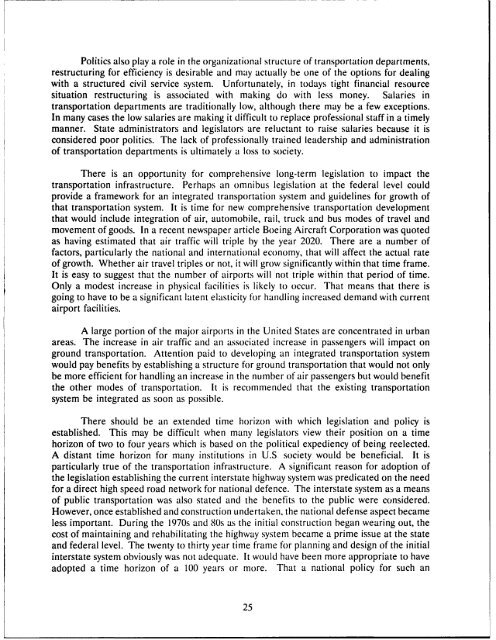Challenges and Opportunities for Innovation in the Public Works ...
Challenges and Opportunities for Innovation in the Public Works ...
Challenges and Opportunities for Innovation in the Public Works ...
You also want an ePaper? Increase the reach of your titles
YUMPU automatically turns print PDFs into web optimized ePapers that Google loves.
Politics also play a role <strong>in</strong> <strong>the</strong> organizational structure of transportation departments,<br />
restructur<strong>in</strong>g <strong>for</strong> efficiency is desirable <strong>and</strong> may actually be one of <strong>the</strong> options <strong>for</strong> deal<strong>in</strong>g<br />
with a structured civil service system. Un<strong>for</strong>tunately, <strong>in</strong> todays tight f<strong>in</strong>ancial resource<br />
situation restructur<strong>in</strong>g is associated with mak<strong>in</strong>g do with less money. Salaries <strong>in</strong><br />
transportation departments are traditionally low, although <strong>the</strong>re may be a few exceptions.<br />
In many cases <strong>the</strong> low salaries are mak<strong>in</strong>g it difficult to replace professional staff <strong>in</strong> a timely<br />
manner. State adm<strong>in</strong>istrators <strong>and</strong> legislators are reluctant to raise salaries because it is<br />
considered poor politics. The lack of professionally tra<strong>in</strong>ed leadership <strong>and</strong> adm<strong>in</strong>istration<br />
of transportation departments is ultimately a loss to society.<br />
There is an opportunity <strong>for</strong> comprehensive long-term legislation to impact <strong>the</strong><br />
transportation <strong>in</strong>frastructure. Perhaps an omnibus legislation at <strong>the</strong> federal level could<br />
provide a framework <strong>for</strong> an <strong>in</strong>tegrated transportation system <strong>and</strong> guidel<strong>in</strong>es <strong>for</strong> growth of<br />
that transportation system. It is time <strong>for</strong> new comprehensive transportation development<br />
that would <strong>in</strong>clude <strong>in</strong>tegration of air, automobile, rail, truck <strong>and</strong> bus modes of travel <strong>and</strong><br />
movement of goods. In a recent newspaper article Boe<strong>in</strong>g Aircraft Corporation was quoted<br />
as hav<strong>in</strong>g estimated that air traffic will triple by <strong>the</strong> year 2020. There are a number of<br />
factors, particularly <strong>the</strong> national <strong>and</strong> <strong>in</strong>ternational economy, that will affect <strong>the</strong> actual rate<br />
of growth. Whe<strong>the</strong>r air travel triples or not, it will grow significantly with<strong>in</strong> that time frame.<br />
It is easy to suggest that <strong>the</strong> number of airports will not triple with<strong>in</strong> that period of time.<br />
Only a modest <strong>in</strong>crease <strong>in</strong> physical facilities is likely to occur. That means that <strong>the</strong>re is<br />
go<strong>in</strong>g to have to be a significant latent elasticity <strong>for</strong> h<strong>and</strong>l<strong>in</strong>g <strong>in</strong>creased dem<strong>and</strong> with current<br />
airport facilities.<br />
A large portion of <strong>the</strong> major airports <strong>in</strong> <strong>the</strong> United States are concentrated <strong>in</strong> urban<br />
areas. The <strong>in</strong>crease <strong>in</strong> air traffic <strong>and</strong> an associated <strong>in</strong>crease <strong>in</strong> passengers will impact on<br />
ground transportation. Attention paid to develop<strong>in</strong>g an <strong>in</strong>tegrated transportation system<br />
would pay benefits by establish<strong>in</strong>g a structure <strong>for</strong> ground transportation that would not only<br />
be more efficient <strong>for</strong> h<strong>and</strong>l<strong>in</strong>g an <strong>in</strong>crease <strong>in</strong> <strong>the</strong> number of air passengers but would benefit<br />
<strong>the</strong> o<strong>the</strong>r modes of transportation. It is recommended that <strong>the</strong> exist<strong>in</strong>g transportation<br />
system be <strong>in</strong>tegrated as soon as possible.<br />
There should be an extended time horizon with which legislation <strong>and</strong> policy is<br />
established. This may be difficult when many legislators view <strong>the</strong>ir position on a time<br />
horizon of two to four years which is based on <strong>the</strong> political expediency of be<strong>in</strong>g reelected.<br />
A distant time horizon <strong>for</strong> many <strong>in</strong>stitutions <strong>in</strong> U.S society would be beneficial. It is<br />
particularly true of <strong>the</strong> transportation <strong>in</strong>frastructure. A significant reason <strong>for</strong> adoption of<br />
<strong>the</strong> legislation establish<strong>in</strong>g <strong>the</strong> current <strong>in</strong>terstate highway system was predicated on <strong>the</strong> need<br />
<strong>for</strong> a direct high speed road network <strong>for</strong> national defence. The <strong>in</strong>terstate system as a means<br />
of public transportation was also stated <strong>and</strong> <strong>the</strong> benefits to <strong>the</strong> public were considered.<br />
However, once established <strong>and</strong> construction undertaken, <strong>the</strong> national defense aspect became<br />
less important. Dur<strong>in</strong>g <strong>the</strong> 1970s <strong>and</strong> 80s as <strong>the</strong> <strong>in</strong>itial construction began wear<strong>in</strong>g out, <strong>the</strong><br />
cost of ma<strong>in</strong>ta<strong>in</strong><strong>in</strong>g <strong>and</strong> rehabilitat<strong>in</strong>g <strong>the</strong> highway system became a prime issue at <strong>the</strong> state<br />
<strong>and</strong> federal level. The twenty to thirty year time frame <strong>for</strong> plann<strong>in</strong>g <strong>and</strong> design of <strong>the</strong> <strong>in</strong>itial<br />
<strong>in</strong>terstate system obviously was not adequate. It would have been more appropriate to have<br />
adopted a time horizon of a 100 years or more. That a national policy <strong>for</strong> such an<br />
25







